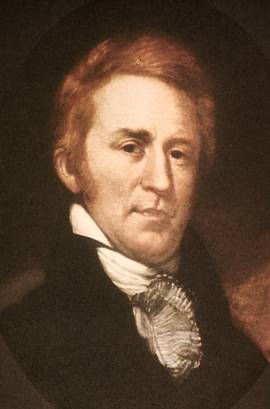Think that you may own a portrait of William Clark? We identify, appraise and issue Certificates of Authenticity (COA) for all portraits of William Clark.
Clark will always be identified with the Lewis and Clark Expedition in the American West, 1804-6. He was also a cartographer, trade negotiator, governor of the Missouri Territory, and diplomat. Clark was not only a subject of portraiture but also a creator of sketches and maps. Perhaps most important, he established the first peaceful working relationships with the Native American Tribes west of the Mississippi River.

Charles Willson Peale, William Clark, 1810, image courtesy of Independence National Historical Park, Philaldephia, PA
Born into a family of distinguished soldiers in Virginia, he had no formal education. His older brother George Rogers Clark (1775-1783) was a hero of the American Revolutionary War and a General in the Virginia Militia. When the American Revolution ended, George took his family to then-fronteir land near Louisville, Kentucky where they made their permanent home.
Following the Treaty of Paris in 1783, the Mississippi and all the land west of it were to be open to citizens of the United States and Great Britain. Britain still held Canada; Spain controlled Texas. The Louisiana Territory also belonged to Spain, and the Spanish were attempting clandestinely to take the Territory from the United States. In 1800, Spain handed over the Territory to France, ruled by the military powerhouse Napoleon. Napoleon was having trouble financing his European battles and sold it to the United States for $15 million.
President Jefferson decided that the U.S. Army must occupy, economically exploit, and control the Territory as quickly as possible. The Army had only about 3,000 troops. Jefferson appointed his personal assistant Infantry Captain Meriweather Lewis and Second Artillary Lieutenant William Clark to led the expedition, which they called the Corps of Discovery. Its purpose was “to explore...the most direct and practicable water communication across the continent, for the purpose of commerce.“ They trained fourteen soldiers for a year before seting out.

Portrait of William Clark at the time of his resignation from the U.S. Army;1807, Image courtesy of Library of Congress, Washington, DC
A major obstacle in the expedition was the hostility of the Sioux Indians. Clark was instrumental in negotiating with the Sioux for the safe passage of the expedition. In the winter of 1804, they built their first fort at Mandan in North Dakota. They also convinced a Native American princess who had married a French Canadian to act as their translator and negotiator. Aged sixteen or seventeen, Sacajawea, of the Shoshone tribe, was the first woman to accompany the expedition to the West. She had been taken from Idaho in a raid by a rival tribe. Her knowledge of the terrain and the people along the way helped the expedition immeasurably.

Alice Cooper, Statute of Sacagawea, (1912), City Park, Portland Oregon
Image courtesy of the Library of Congress, Washington, DC
William Clark also took along his slave York. York became the first African-American to vote in the United States. The Native Americans had never seen an African-American; Lewis and Clark used the Native American's curiosity about someone of a different race to their advantage. Clark's letters show how valuable York's contribution to the expedition turned out to be. He was one of the only slaves in early American recorded history to be permitted to carry a gun. Yet while free men on the expedition were rewarded with a large amount of money and land, Clark refused to release York from slavery until after 1815, nearly ten years after the Lewis and Clark Expedition.
In 1807, Clark resigned his Army commission. He had helped establish and run the system of Factories, or trading posts, which bought and sold goods with the Native American tribes, including specially-made blankets in exchange for fur. This system of factories evolved into the Bureau of Indian Affairs. After the War of 1812, the Factory system was decimated and private trading companies took over the trade with Native Americans. Clark was appointed the first superintendent of Indian Affairs. In 1814, he became Governor of the Missouri Territory. He died in St. Louis in 1838.
Please contact Art Experts with your questions about portraits of William Clark or works of art related to him at info@artexpertswebsite.com.
